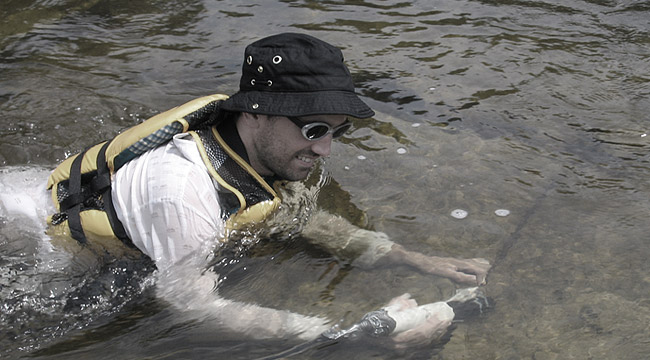
By Patrick McDonagh
The groundwater footprint. If you haven’t heard that term yet, read on, because it soon could become as familiar as “carbon footprint.”
Groundwater, which originates in rain, snow or ice, collects or flows beneath the earth’s surface, providing the water to replenish aquifers, springs and wells. The groundwater footprint is essentially a tool for evaluating where and how this groundwater can be used sustainably.
Department of Civil Engineering and Applied Mechanics professor Tom Gleeson says “about two billion people drink groundwater every day, and it’s just as important to industry and agriculture because 40 per cent of irrigation water around the globe also comes from groundwater.”
But Gleeson’s research shows there is a problem.
Working in collaboration with hydrologists at Utrecht University in the Netherlands, Gleeson determined that the global groundwater footprint is 3.5 times the size of the world’s 783 large regional aquifers. What this means is that groundwater is being used unsustainably in many parts of the world.
Though 80 per cent of aquifers have a groundwater footprint less than their area, some regions with a hugely unsustainable footprint are driving up global water usage. In these regions, notably in Asia and North America, humans are overexploiting the resource, primarily for agriculture.
The effect of depleting these aquifers extends well beyond farming, however. Gleeson says a quarter of the world’s population lives in regions where groundwater is overused, so, in addition to reducing the water available for drinking and irrigation, unsustainable groundwater use could cause ecosystem shifts.

Although groundwater depletion has global ramifications in terms of food security, Gleeson said solutions are going to have to happen locally or regionally because each region and each aquifer has different social, economic and political conditions.
“But while there may not be one solution, we can devise broadly applicable approaches, including valuing groundwater differently, regulating and managing it better, and, in some cases, planning our water management strategies over a longer time frame.
“Groundwater moves very slowly, so if we try to manage this resource over the short term, then we’re not taking into account how it flows naturally.”
One thing is clear; the regions most affected should become the focus of future groundwater-management priorities.
Currently Gleeson is tracking the groundwater footprint for various crops from two of the most depleted aquifers in the U.S. – the California Central Valley aquifer and the Midwest’s High Plains’ aquifer – to learn how to break the groundwater footprint down according to specific crops.
“We’re hoping to learn what kinds of food are best to grow for specific environments, and looking at how and when to grow these foods,” he said.
With two degrees in Geology and a doctorate in Civil Engineering, Gleeson wears the fundamental and applied science mantles with equal ease.
In describing his research team, he said, “we’re working to understand how groundwater systems work – that’s the fundamental science. And then we’re using that knowledge to develop new tools for applied research that could teach us how we can use this resource sustainably.”
This article originally appeared in the Faculty of Engineering’s Winter 2014 Dean’s Report newsletter.
